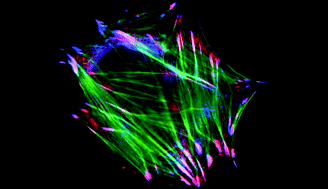Cellular chemomechanics at interfaces: sensing, integration and response†
Abstract
Living cells are complex entities whose remarkable, emergent capacity to sense, integrate, and respond to environmental cues relies on an intricate series of interactions among the cell's macromolecular components. Defects in mechanosensing, transduction,or responses underlie many diseases such as cancers, immune disorders, cardiac hypertrophy, genetic malformations, and neuropathies. Here, we highlight micro- and nanotechnology-based tools that have been used to study how chemical and mechanical cues modulate the responses of single cells in contact with the

- This article is part of the themed collection: Cells and proteins at interfaces

 Please wait while we load your content...
Please wait while we load your content...